
Dead common murres were found on the beach in Cochrane Bay, Prince William Sound on Jan 10, 2016. These birds were part of the large die-off of common murres across the Gulf of Alaska in 2015-2016. (Photo: Sarah Schoen/USGS Alaska Science Center)
Written by Jessica Corbett / Common Dreams January 16, 2020
On the heels of new research showing that the world’s oceans are rapidly warming, scientists revealed Wednesday that a huge patch of hot water in the northeast Pacific Ocean dubbed “the blob” was to blame for killing about one million seabirds.
The peer-reviewed study, published in the journal PLOS ONE, was conducted by a team of researchers at federal and state agencies, conservation groups, and universities. They tied the mass die-off to “the blob,” a marine heatwave that began forming in 2013 and grew more intense in 2015 because of the weather phenomenon known as El Niño.
“About 62,000 dead or dying common murres (Uria aalge), the trophically dominant fish-eating seabird of the North Pacific, washed ashore between summer 2015 and spring 2016 on beaches from California to Alaska,” the study says. “Most birds were severely emaciated and, so far, no evidence for anything other than starvation was found to explain this mass mortality. Three-quarters of murres were found in the Gulf of Alaska and the remainder along the West Coast.”
Given that previous studies have shown “that only a fraction of birds that die at sea typically wash ashore,” the researchers put the death toll closer to a million.
“The magnitude and scale of this failure has no precedent,” lead author John Piatt, a research biologist at the U.S. Geological Survey’s Alaska Science Center and an affiliate professor at the University of Washington, said in a statement. “It was astonishing and alarming, and a red-flag warning about the tremendous impact sustained ocean warming can have on the marine ecosystem.”
A New Study About the Death of 1 Million Seabirds Should Scare the Crap Out of You #ClimateReality #ClimateActionhttps://t.co/7A17ZEGV1x pic.twitter.com/OJ01VIGlxP
— CenterForTheBlueEconomy_MIIS (@CBE_MIIS) January 16, 2020
Piatt and study co-author and University of Washington professor Julia Parrish explained that the team believes the blob—which spanned hundreds of miles—limited food supply in the region, leading the birds to starve.
“Think of it as a run on the grocery stores at the same time that the delivery trucks to the stores stopped coming so often,” Parrish said. “We believe that the smoking gun for common murres—beyond the marine heatwave itself—was an ecosystem squeeze: fewer forage fish and smaller prey in general, at the same time that competition from big fish predators like walleye, pollock, and Pacific cod greatly increased.”
Piatt added that “food demands of large commercial groundfish like cod, pollock, halibut, and hake were predicted to increase dramatically with the level of warming observed with the blob, and since they eat many of the same prey as murres, this competition likely compounded the food supply problem for murres, leading to mass mortality events from starvation.”
According to CNN, which reported on the study Thursday:
The blob devastated the murres’ population. With insufficient food, breeding colonies across the entire region had reproductive difficulties for years afterward, the study said. Not only did the population decline dramatically, but the murres couldn’t replenish those numbers.
During the 2015 breeding season, three colonies didn’t produce a single chick. That number went up to 12 colonies in the 2016 season—and in reality it could be even higher, since researchers only monitor a quarter of all colonies.
Thomas Frölicher, a climate scientist at the University of Bern in Switzerland who was not involved in the new study, discussed the blob’s connection to the human-caused planetary emergency with InsideClimate News.
“It was the biggest marine heatwave so far on record,” said Frölicher, who noted that such events have doubled in frequency over the past few decades. “Usually, we are used to heatwaves over land. They are much smaller in size, and they do not last as long. In the ocean, this heatwave lasted two or three years.”
Frölicher warned that “if we follow a high-greenhouse-gas-emissions scenario, these heatwaves will become 50 times more frequent than preindustrial times” by 2100. He said that even if the international community achieves a low-emissions scenario in line with the Paris climate agreement, marine heatwaves would still be 20 times more frequent.
“What that means is that in some regions, they will become permanent heatwaves,” he added. “This gives us some insight into the future.”
The study—which its authors expect to inform research on other mortality events related to marine heatwaves—was published just weeks after University of Washington scientists found what some have called “the blob 2.0” forming in the Pacific. That discovery came as “quite a surprise” to those researchers.
University climatologist Nick Bond told local media that “the original blob was so unusual, and stood above the usually kind of variations in the climate and ocean temperatures that we thought ‘wow, this is going to be something we won’t see for quite a while.'”
Pacific 'blob' heatwave feared to have killed a million birds
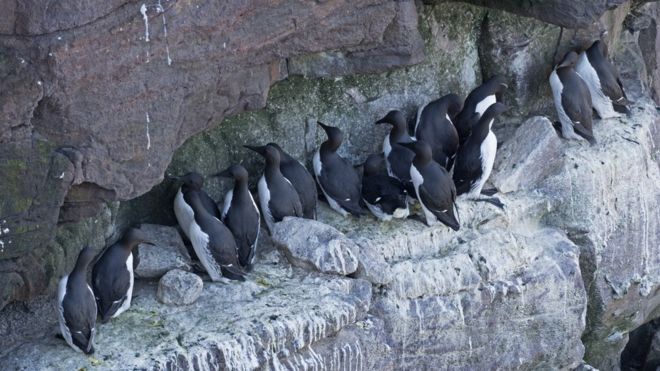 GETTY IMAGES
GETTY IMAGES
Tens of thousands of seabirds found dead on the west coast of the US in 2015-16 were probably killed by an unprecedented heatwave, scientists say.
Around 62,000 common murres washed up on the coast of the Pacific Ocean but up to a million birds are thought to have died.
The scientists said that warmer sea waters, known as the "blob", led to a shortage of the fish the birds feed on.
Other fish, birds and mammals also died in the same period.
The study, published on Wednesday by the PLOS One scientific journal, found that the seabirds probably starved to death due to a 1,000-mile body of warmer water that affected the north-eastern Pacific between 2013 and 2016.
The higher temperatures impacted their food supply, with diminishing supplies of plankton leading to a both a drop in the population of the smaller fish eaten by the birds and increased competition from other predators.
More than three-quarters of the dead murres were found in the Gulf of Alaska, but the actual number is likely to be around one million as only a small number of birds that die at sea are normally washed ashore.
The scientists said that mass deaths of murres, also known as common guillemots, happen sporadically, but described the scale of the incident in 2015-16 as "unprecedented and astonishing".
Study links warming to 'Blob' that killed Pacific seabirds
About 1 million common murres died during a 2015-16 heat wave, scientists have said. Researchers believe that a disrupted food supply led to the mass die-off of the North Pacific seabirds.
Approximately 1 million seabirds known as the common murre died because of food-supply disruptions during a heat wave from summer 2015 to spring 2016, according to a study published Wednesday in PLOS One. Julia Parrish, a University of Washington ecologist and co-author of the paper, linked the "relatively new" increased frequency of such heat waves to climate change.
The study called the number of birds — many of breeding age — killed over a geographic area the size of Canada "unprecedented and astonishing." According to researchers, "the most powerful marine heat wave on record," which ran from 2014 to 2016, created a mass of seawater known as "the Blob." That coincided with the warmed Pacific of an El Nino period.
About 62,000 emaciated murres washed ashore dead or dying along the North American Pacific coastline during the heat wave. Scientists estimate the total deaths at between 500,000 and 1.2 million.
'Very different environment'
Parrish said the heat wave had a twofold effect. First, elevated temperatures reduced the quality and quantity of phytoplankton, reducing the quantity and quality of herring, sardines and anchovies: fish eaten by common murres, which measure 1 foot (30 centimeters), fly fast and can hunt 650 feet below the water's surface. Second, warming waters meant that salmon and Pacific cod, which compete with the murres, needed to eat more.
The murres' need to consume half of their body mass every day has become their evolutionary "Achilles heel" as the climate changes, John Piatt, a research biologist at the US Geological Survey's Alaska Science Center and the paper's lead author, told the AFP news agency. "Everything they do depends on that breast muscle," he said. "When they can't eat three or four days, they burn up all that muscle" — and can no longer fly or dive.
Murre colonies across the entire region failed to produce chicks for years during and after the heat wave event, the study found. Several other species experienced mass die-offs during the same period, including tufted puffins, Cassin's auklets, sea lions and baleen whales. But, by all metrics, including overall number and geographic extent, the common murres experienced by far the largest die-off.
Taken together, the mass deaths demonstrate that "a warmer ocean world is a very different environment and a very different coastal ecosystem for many marine species," Parrish said, calling seabirds, as highly visible members of that system, "bellwethers of that change."
DW mkg/sms (AFP, PLOS One)
'The blob,' food supply squeeze to blame for largest seabird die-off
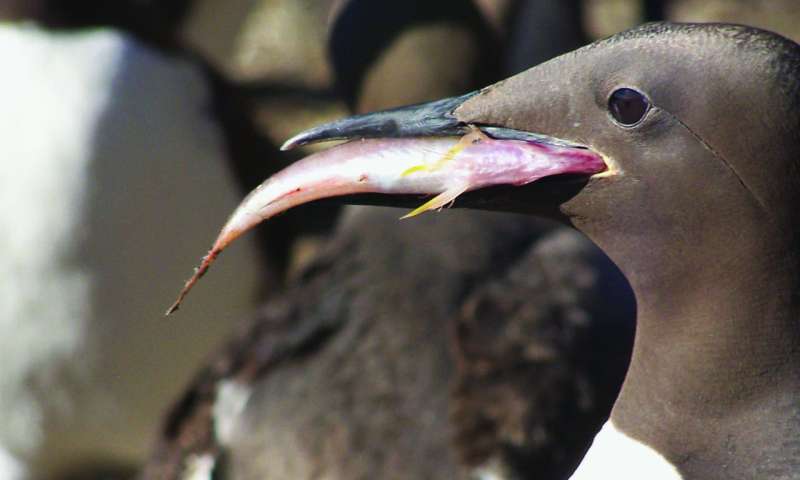
The common murre is a self-sufficient, resilient bird.
Though the seabird must eat about half of its body weight in prey each day, common murres are experts at catching the small "forage fish" they need to survive. Herring, sardines, anchovies and even juvenile salmon are no match for a hungry murre.
So when nearly one million common murres died at sea and washed ashore from California to Alaska in 2015 and 2016, it was unprecedented—both for murres, and across all bird species worldwide. Scientists from the University of Washington, the U.S. Geological Survey and others blame an unexpected squeeze on the ecosystem's food supply, brought on by a severe and long-lasting marine heat wave known as "the blob."
Their findings were published Jan. 15 in the journal PLOS ONE.
"Think of it as a run on the grocery stores at the same time that the delivery trucks to the stores stopped coming so often," explained second author Julia Parrish, a UW professor in the School of Aquatic and Fishery Sciences. "We believe that the smoking gun for common murres—beyond the marine heat wave itself—was an ecosystem squeeze: fewer forage fish and smaller prey in general, at the same time that competition from big fish predators like walleye, pollock and Pacific cod greatly increased."
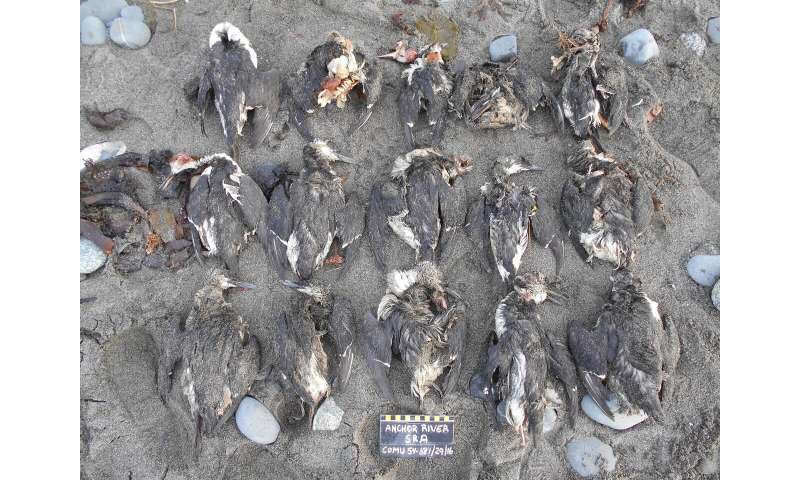
Common murres nest in colonies along cliffs and rocky ledges overlooking the ocean. The adult birds, about one foot in length, are mostly black with white bellies, and can dive more than two football fields below the ocean's surface in search of prey.
Warmer surface water temperatures off the Pacific coast—a phenomenon known as "the blob"—first occurred in the fall and winter of 2013, and persisted through 2014 and 2015. Warming increased with the arrival of a powerful El Niño in 2015-2016. A number of other species experienced mass die-offs during this period, including tufted puffins, Cassin's auklets, sea lions and baleen whales. But the common murre die-off was by far the largest any way you measure it.
From May 2015 to April 2016, about 62,000 murre carcasses were found on beaches from central California north through Alaska. Citizen scientists in Alaska monitoring long-term sites counted numbers that reached 1,000 times more than normal for their beaches. Scientists estimate that the actual number of deaths was likely close to one million, since only a fraction of birds that die will wash to shore, and only a fraction of those will be in places that people can access.
Many of the birds that died were breeding-age adults. With massive shifts in food availability, murre breeding colonies across the entire region failed to produce chicks for the years during and after the marine heat wave event, the authors found.
"The magnitude and scale of this failure has no precedent," said lead author John Piatt, a research biologist at the U.S. Geological Survey's Alaska Science Center and an affiliate professor in the UW School of Aquatic and Fishery Sciences. "It was astonishing and alarming, and a red-flag warning about the tremendous impact sustained ocean warming can have on the marine ecosystem."
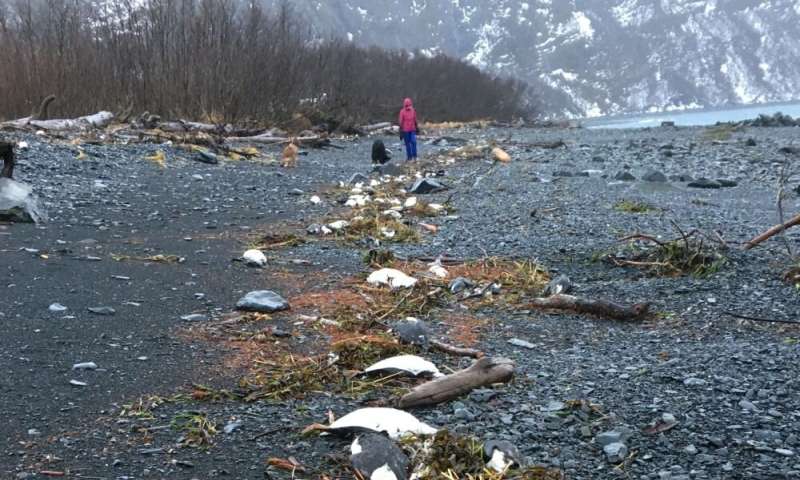
From a review of fisheries studies conducted during the heat wave period, the research team concluded that persistent warm ocean temperatures associated with "the blob" increased the metabolism of cold-blooded organisms from zooplankton and small forage fish up through larger predatory fish like salmon and pollock. With predatory fish eating more than usual, the demand for food at the top of the food chain was unsustainable. As a result, the once-plentiful schools of forage fish that murres rely on became harder to find.
"Food demands of large commercial groundfish like cod, pollock, halibut and hake were predicted to increase dramatically with the level of warming observed with the blob, and since they eat many of the same prey as murres, this competition likely compounded the food supply problem for murres, leading to mass mortality events from starvation," Piatt said.
As the largest mass die-off of seabirds in recorded history, the common murre event may help explain the other die-offs that occurred during the northeast Pacific marine heat wave, and also serve as a warning for what could happen during future marine heat waves, the authors said. UW scientists recently identified another marine heatwave forming off the Washington coast and up into the Gulf of Alaska.
"All of this—as with the Cassin's auklet mass mortality and the tufted puffin mass mortality—demonstrates that a warmer ocean world is a very different environment and a very different coastal ecosystem for many marine species," said Parrish, who is also the executive director of the Coastal Observation and Seabird Survey Team, known as COASST. "Seabirds, as highly visible members of that system, are bellwethers of that change."
More information: Piatt JF, Parrish JK, Renner HM, Schoen SK, Jones TT, Arimitsu ML, et al. (2020) Extreme mortality and reproductive failure of common murres resulting from the northeast Pacific marine heatwave of 2014-2016. PLOS ONE (2020). DOI: 10.1371/journal.pone.0226087
Warm ocean water triggered vast seabird die-off, experts say
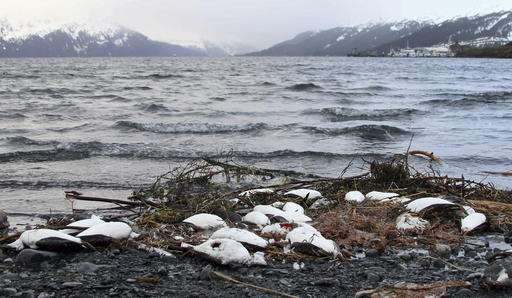
A year after tens of thousands of common murres, an abundant North Pacific seabird, starved and washed ashore on beaches from California to Alaska, researchers have pinned the cause to unusually warm ocean temperatures that affected the tiny fish they eat.
Elevated temperatures in seawater affected wildlife in a pair of major marine ecosystems along the West Coast and Canada, said John Piatt, a research wildlife biologist for the U.S. Geological Survey. Common murres are an indicator of the regions' health.
"If tens of thousands of them are dying, it's because there's no fish out there, anywhere, over a very large area," Piatt said.
To see such effect over two sizeable marine ecosystems is extraordinary, he said.
Deaths of common murres in Alaska likely were multiplied when starving birds in December 2015 were hit by vicious Gulf of Alaska winter storms, Piatt said.
Common murres look like thin penguins. They can fly miles in search of schools of finger-length fish and can dive and swim nearly 600 feet deep to capture them. However, the birds' high metabolism means they have to eat a lot. If they don't eat prey matching 10 to 30 percent of their body mass daily, they can use up fat reserves and drop to a critical threshold for starvation within three days.
Common murres eat small forage fish: capelin, from the smelt family, and juvenile pollock, which as adults are caught for fast-food fish sandwiches. Both fish were largely absent when the National Marine Fisheries Service conducted surveys in summer 2015.
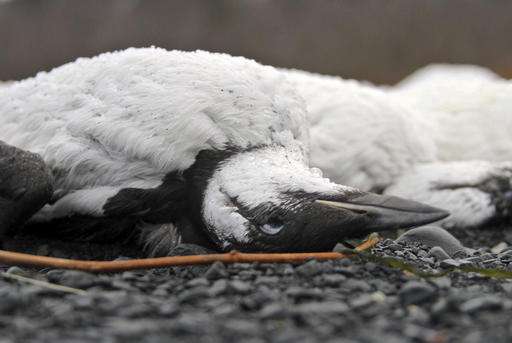
Common murres paid the price. Volunteers and federal researchers last year counted the carcasses of 46,000 dead murres in Alaska and another 6,000 in California, Oregon and Washington.
Die-offs of seabirds occur periodically, but this one was spectacular. Only a fraction of the dead birds likely reached shore, Piatt said. And only a fraction of Alaska coastline was surveyed. A conservative extrapolation indicates 500,000 or more common murres died, Piatt said.
Nearly all were emaciated. As birds starved, they consumed their own fat and protein until they lost deadly amounts of body mass.
"You can't keep yourself heated, and then you die," Piatt said. "It's an agonizing, awful death. And then on top of that, some of them probably drowned."
Starting in 2014, the temperature in the upper 300 feet of water was as much as 4.5 degrees warmer than normal. NASA explained it like this: An unusually strong and persistent ridge of atmospheric high pressure appeared over the northeastern Pacific, weakening winds and easing normal, wind-driven churning, which promoted upwelling of deep, cold water to the surface. It led to a lens of unusually warm surface water that a University of Washington meteorologist dubbed "the Blob."
Forage fish feed on zooplankton, and cold water produces the biggest, fattiest versions, said Shannon Atkinson, a physiologist and researcher at the University of Alaska Fairbanks.
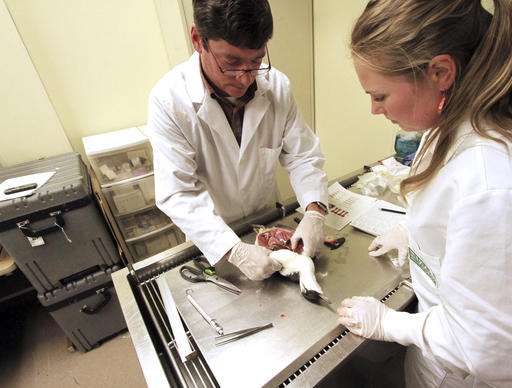
"What that means is there's not as much energy, and the energy that's being transferred up the food web is not as energetically rich," Atkinson said.
Warm ocean temperatures also affect big North Pacific fish such as halibut, cod, pollock and arrowtooth flounder, Piatt said. Their metabolism increases as the temperature increases, and they have to eat more.
"The dominant food for those fish is—get ready—juvenile pollock, capelin, sand lance," Piatt said. "These fish are in direct competition with the birds now, and typically in most of these northern ecosystems, the large, predatory fish eat an order of magnitude more of those forage prey than the birds and mammals combined."
The rates of carcass recovery by volunteers monitoring beaches in the Gulf of Alaska returned to normal levels in July 2016, Piatt said. However, common murres continued to have trouble finding food, and it showed up in breeding, he said.
Common murres lay eggs in approximately 230 Alaska cliff colonies. Heather Renner, supervisory wildlife biologist at the Alaska Maritime National Wildlife Refuge, monitors some of the largest.
"In 2016, we had widespread breeding failure at all of the colonies in the Gulf of Alaska, as well as the Bering Sea," she said. "It was a highly unusual event. Murres don't fail regularly."
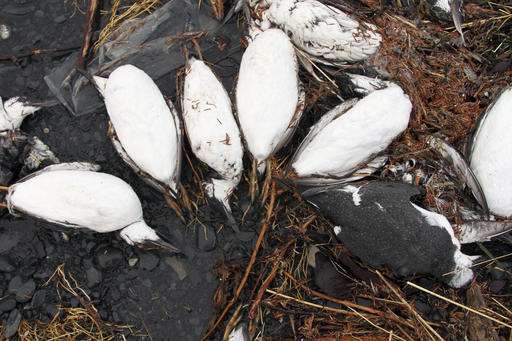
Breeding was normal at colonies in the Arctic and the Aleutians, she said.
There's no question for Piatt that Pacific warmth was the ultimate cause of the common murre die-off.
"They died of starvation because there was no food," Piatt said. "There was no food because there was no fish. And there was no fish because these warm waters did something to them."
© 2017 The Associated Press. All rights reserved.
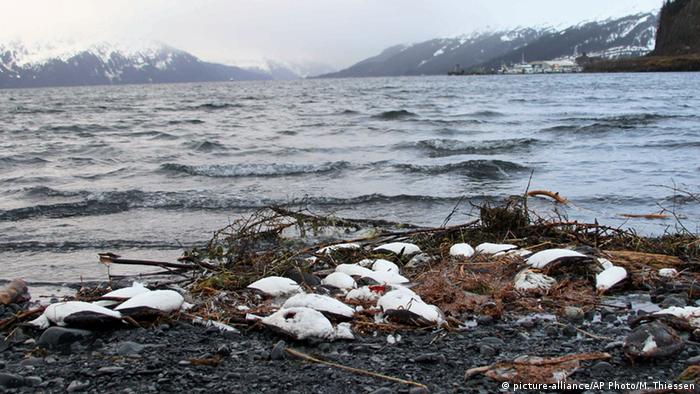
No comments:
Post a Comment